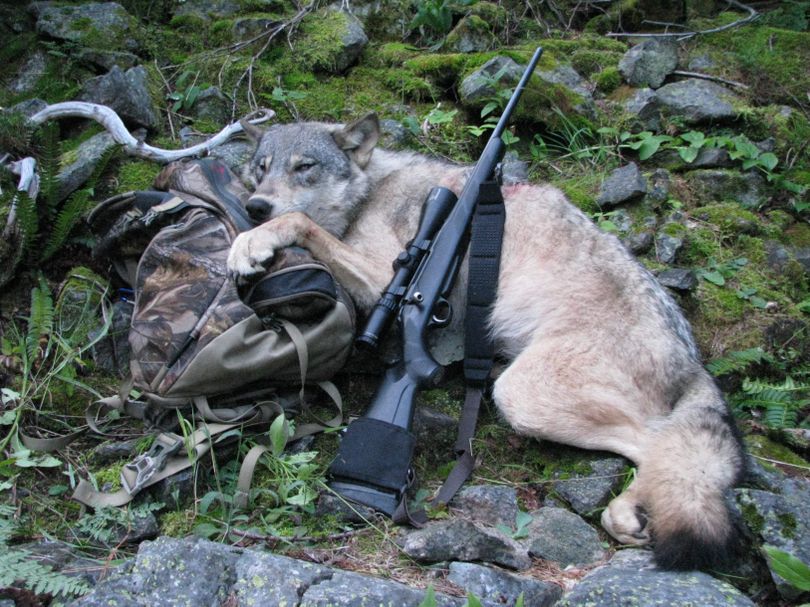Survey: Idaho well above federal quota for wolves

PREDATORS -- Although fewer than half of Idaho's wolf packs have been surveyed this winter, state wildlife officials already have documented the number of breeding pairs exceeds federal requirements.
Jim Hayden, Idaho Fish and Game's head wolf biologist, said teams have surveyed 30 of the state's 107 known wolf packs. Of those 30 surveyed packs, 22 included breeding pairs.
The minimum requirement for breeding pairs set by the U.S. Fish and Wildlife Service is 15 for the entire state. "At this point, there are 77 more packs that we have not examined," he told The Spokesman-Review on Thursday.
In a briefing to the Fish and Game Commission in Boise last week, Hayden estimated Idaho holds roughly 1,000 wolves and probably many more breeding pairs than have been confirmed so far.
After the 1995 re-introduction of wolves into Idaho, the species multiplied quickly, peaking around 2009. The number of wolves in Idaho has declined since then, as expected, as the species was de-listed from endangered species protections and the state approved limited hunting and trapping seasons.
Federal wolf reintroduction agreements set the minimum acceptable wolf population in Idaho at 150.
The number of wolves in preliminary estimates is well above the thresholds that would put them back under federal endangered species protections, Hayden said.
Other gray wolf recovery states, including Montana, Wyoming, Washington and Oregon, also are required to survey wolves and file annual reports, which usually are released in March or April.
Following is more detail from the AP report:
The estimate of 1,000 wolves in Idaho is based on a sampling of wolf packs to determine pack size, Hayden said, and then determining the number of wolves associated with packs. He said about 10 to 15 percent of wolves are lone wolves not associated with a pack, so that is added.
The number of wolves in Idaho increased steadily since their reintroduction in 1995 and peaked in 2009 just before hunting and trapping began. It has declined each year since.
A final estimate for the total number of wolves currently in Idaho won’t be made until April. But Hayden said that through mid-January it appears the wolf population has declined slightly from the estimate of 1,036 wolves as of Jan. 1, 2014.
Hayden noted that the report prepared for the Idaho Fish and Game Commission meeting on Thursday included an estimated range of 15-25 breeding pairs in Idaho. Hayden said those numbers were meant to show that the state is safely above the 15 minimum.
The declining wolf population reflects Idaho’s poor management of the species, said Andrea Santarsiere, an attorney for the Center for Biological Diversity.
“After fighting tooth and nail for the right to manage wolf populations, Idaho has already proven its true goal is to wipe out most of the state’s wolves,” she said in a statement. “This report should be a wake-up call to Fish and Wildlife Service.”
Landers note: The recovery plan clearly states the numbers of wolves states agreed to maintain post recovery, and Idaho is far above those minimums. Never did the wolf recovery plans suggest there would be a wolf on every hillside. The minimum agreement for Idaho is 150 wolves.
The state agency spends much of its energy documenting breeding wolf pairs, Hayden said.
For a breeding wolf pair to be counted, Hayden said, the pair has to have survived a year and at least two of their pups have to survive. To prove those conditions are meant, wildlife biologists trap wolves to put on collars, use remote cameras to capture images of wolves, and collect wolf scat to get DNA.
Hayden said DNA from the 1,200 samples collected so far can also be compared to the DNA of wolves killed by hunters and trappers to determine harvest rates. The report to the commissioners said the agency tried to collect wolf scat in the Frank Church Wilderness in central Idaho with three workers hiking a total of 503 miles, but eventually gave up due to the difficulty of the terrain and lack of success in finding samples.
The presentation on Thursday by Hayden to the Idaho Fish and Game Commission was for information only, and the state agency is requesting no action concerning wolves from the commissioners.